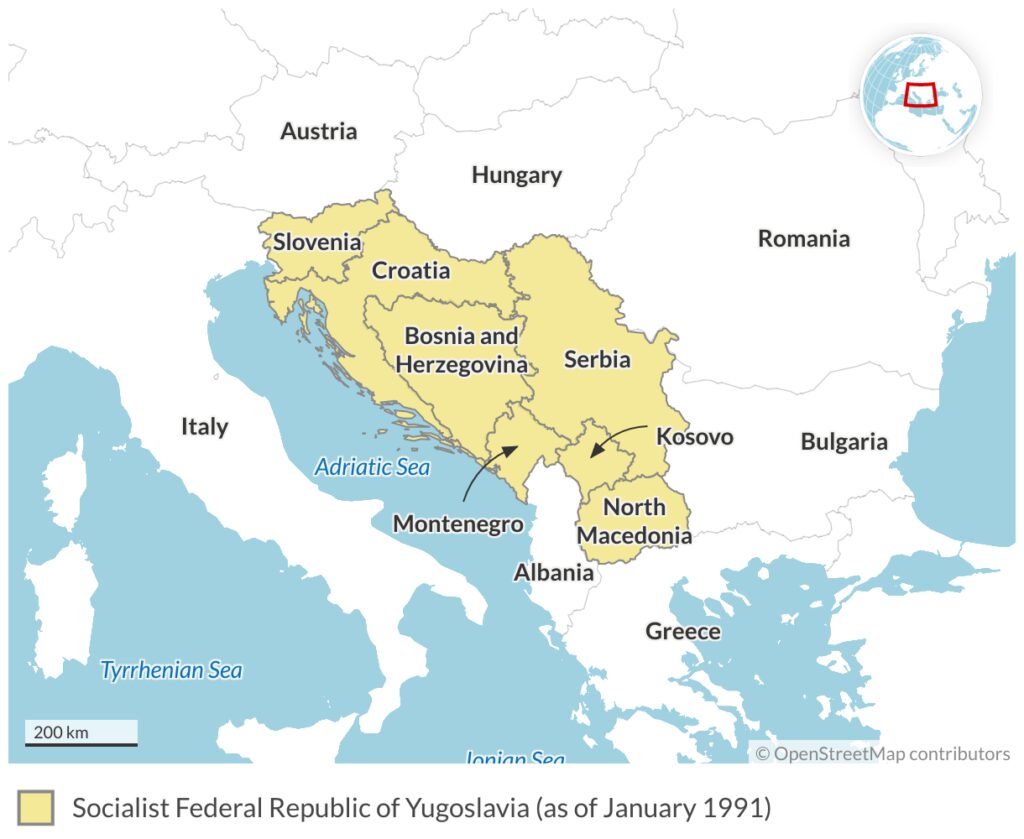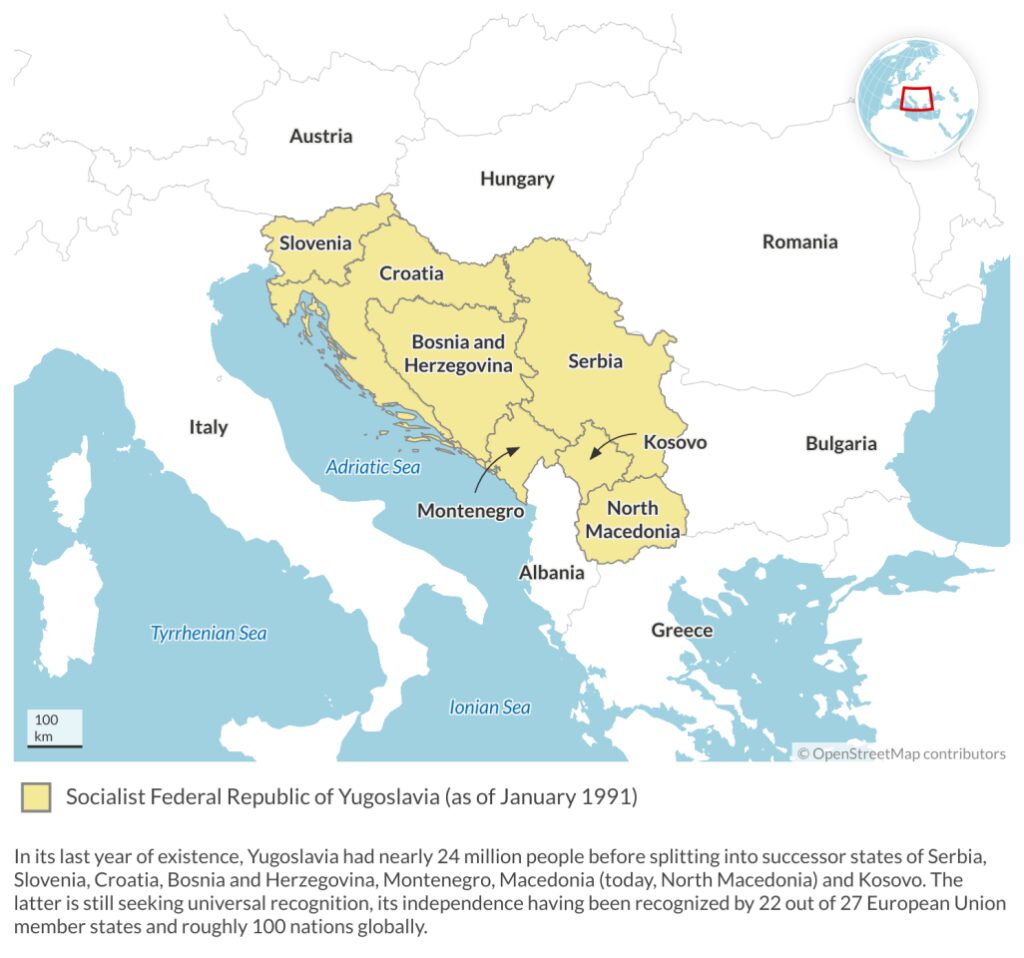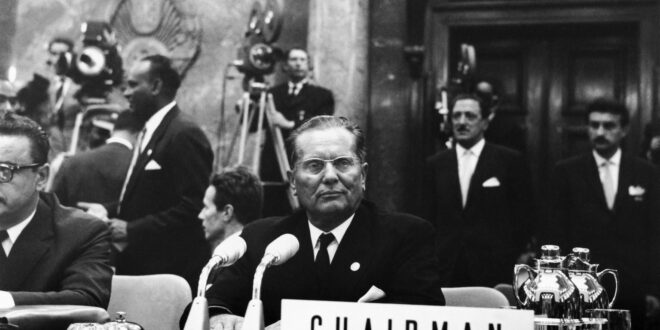Leading nonaligned nations are touted as possible mediators in helping to end Russia’s war on Ukraine. It remains to be seen what role Belgrade will play.
- Belgrade hosted key events in the nonaligned movement 60 years apart
- Serbia supports Ukraine’s territorial integrity but refuses to sanction Russia
- In many ways, Serbia’s foreign policy resembles that of Tito’s Yugoslavia
After World War II, under communism and during the Cold War, Yugoslavia was quite an unusual European country.
Its leader, Josip Broz Tito, was a co-initiator of the 1955 Asia-Africa Conference, also known as the Bandung Conference. The gathering, hosted by Indonesian President Sukarno, was attended by China’s Premier Zhou Enlai, India’s Prime Minister Jawaharlal Nehru, Egypt’s President Gamal Abdel Nasser, Ghana’s future President Kwame Nkrumah and many other historic figures. It accelerated the decolonization process and led to the founding of the Non-Aligned Movement, or NAM, which was formalized at a 24-nation summit in Belgrade in 1961.
In that way, Yugoslavia took on a leading role in the global quest to free Asia and Africa from European dominance. The movement strove to steer clear of taking the side of either contender for global hegemony, the United States-led West and the Soviet Union. Now, in a multipolar post-Cold War era, nonaligned countries perhaps can be best described as multi-aligned nations. But neutrality still has its benefits.
Europe’s nonaligned nations
Within Europe, a conference that later morphed into an organization came into being in 1975. It aimed to build democratic structures and overcome the deep divisions between the two enemy military alliances, NATO and the Warsaw Pact. Through cooperation and military confidence-building, Europe’s security was to be strengthened. Building on a process initiated in Helsinki in 1972, the Conference on Security and Cooperation in Europe, CSCE, was born. In 1994, the entity was renamed the Organization for Security and Cooperation in Europe, or OSCE, which has 57 member states today.
Squeezed between these two blocs was a core group of neutral countries, Switzerland, Austria, Sweden, Finland, Ireland, Malta and Cyprus. Along with Yugoslavia, they made up Europe’s N+N group of neutral and nonaligned states. The N+N played a crucial role in advancing the ambitious goal of constructing security through cooperation and making Europe free and whole again. It was no coincidence that the start of the Helsinki process, leading to the establishment of what is now the OSCE, took place in neutral Finland and that Vienna was chosen as the permanent seat, demonstrating the valuable mediating function of the N+N states.
Facts & figures
Yugoslavia before its collapse


Yugoslavia’s special role
Simultaneously, the Socialist Federal Republic of Yugoslavia played in the world league of diplomacy, the global movement of nonaligned countries comprising about 120 members. It grew second in size only to the United Nations. Yugoslavia (and, in theory, every successor state that had inherited a portion of it) had become accustomed to playing a prominent role alongside the big actors of the world, between the Western alliance embodied by NATO and the Soviet-controlled Warsaw Pact.
But after the dissolution of Yugoslavia was complete in 1992, with nearly 24 million people finding themselves now part of various successor states, the step-by-step inclusion of Slovenia, Croatia, Montenegro and North Macedonia in NATO ended their involvement in the nonaligned camp.
During the 40 years between the early 1950s and Yugoslavia’s ultimate demise, its global economic ties and international relations were thriving. Yugoslav engineering companies were busy around the world. A Yugoslav passport offered almost universal visa-free travel, from the U.S. to the Soviet Union, China, Europe and the Arab world. While other successor states could also hold on to traditions from the Tito era, Serbia, with the advantage of inheriting Belgrade as the capital, identified strongest with the former Yugoslavia. Hence it is not surprising that Belgrade would play the nonaligned card, even though the Cold War has passed.
The slogan of building a multipolar world in 2021 was a clear message of opposition to the U.S.In 2021, Serbia and Azerbaijan hosted a summit in Belgrade to commemorate the nonaligned movement’s 60th anniversary, inviting NATO member Turkey and also Russia, the successor to the Soviet Union, to participate as guests. The slogan of building a multipolar world in 2021 was a clear message of opposition to the U.S. Unsurprisingly, strong comments by Ukraine and Kosovo fiercely criticized Russia and Serbia.
Beyond the ceremony and nostalgia of the 2021 summit, Serbia used the event to lobby against universal recognition of Kosovo’s independence. When in November 2022 the 28th Belgrade Auteur Film Festival showed some fascinating Yugoslav film reels collected by Mila Turajlic and produced throughout the history of the nonaligned movement, the large hall in the former Trade Union building was crammed with people. Yugoslavia’s last foreign minister, 98-year-old Budimir Loncar, traveling from his home in Croatia for the showing, recalled the NAM’s quest for world peace and exhorted the audience to heed the lessons of history.
Facts & figures
The 24 participating nations in the 1961 Conference of Non-Aligned Nations in Belgrade
Afghanistan
Algeria
Burma (Myanmar)
Cambodia
Ceylon (Sri Lanka)
Cyprus
Cuba
Egypt
Ethiopia
Ghana
Guinea
India
Indonesia
Iraq
Lebanon
Mali
Morocco
Nepal
Saudi Arabia
Somalia
Sudan
Tunisia
Yemen
Yugoslavia
A future for neutrality in Europe?
Serbia’s official policy of nonalignment and neutrality rests on historical foundations, underpinning Belgrade’s pursuit of Serbian-defined national interests. Those include refusing to join Western sanctions against Russia while criticizing Moscow’s aggression against Ukraine. This balancing act is bringing the country under “huge, terrible” pressure, in the words of Serbia’s President Aleksandar Vucic. The European Union has been persistently demanding, without success, Belgrade’s alignment with the EU’s Common Foreign and Security Policy. Sometimes Serbia is threatened that it will have to pay a political price for not aligning with the EU policy (even though Serbia seeks membership in the bloc) and for working against Bosnia and Herzegovina’s desire to join NATO. Such pressure is a burden but can be sustained thanks to Serbia’s central geographical position on the Balkans peninsula along the Danube and Sava rivers and its relatively large size of Serbia (6.7 million inhabitants).
Can nonaligned states help end Russia’s war in Ukraine?
With war raging in Europe’s east and a deepening economic crisis, finding ways to stop Moscow’s assault on the territorial integrity of Ukraine may appear unrealistic today. However, reverting to diplomacy could soon become imperative and prompt more pragmatic thinking for the sake of global security. It is noteworthy that effective communication lines with the warring sides have so far best been kept open by states with at least a neutral inkling.
Turkey has been most effective in playing a mediating role and, together with the UN, managed to broker the July 22, 2022, grain and fertilizer export agreements with Ukraine and Russia. Since then, an Istanbul-based office has overseen the shipping of fertilizers and more than 15 million tons of badly needed grain from both countries to a hungry world. Ankara could be seen in this regard as continuing its beneficial policy of strict neutrality adopted during World War II.
While politically and economically aligned with its EU partners, Austria is maintaining military neutrality, just like Switzerland. Austria looks back on many decades of good cooperation with Moscow, starting in 1955 after Vienna decided to settle for official neutrality, palatable both to the Soviet Union and the West. Today, Vienna is a seat of UN organizations, the OSCE, OPEC and many other international bodies. More than two centuries ago, Austrian statesman Klemens von Metternich steered the Congress of Vienna, which produced a durable peace for Europe after the Napoleonic Wars. Some, therefore, try to imagine a Congress of Vienna 2.0, but at the moment the preconditions for such a logical solution are not yet in sight.
Serbia’s potential role in global diplomacy cannot be dismissed and needs to be watched.France’s President Emmanuel Macron, the longest-serving leader among EU heavyweights, has communicated directly with President Vladimir Putin on many occasions. In 2019, Mr. Macron warned NATO of becoming “brain dead,” with Europe unable to rely on the U.S. to defend it under President Donald Trump. France has a long record of skepticism toward NATO and the U.S. In 1966, then-President Charles de Gaulle opted to leave the military integration structure of NATO. A year later, the influential French writer and politician Jean-Jacques Servan-Schreiber condensed his apprehensions in the bestseller book, “The American Challenge” (“Le defi Americain”).
Is there again a role for Belgrade’s diplomacy?
Serbia is not a member of NATO, let alone the EU. Yet it is anchored in the European economic orbit. But it also has an unsettled issue with Kosovo, for which Russia is giving its valuable support as a veto-wielding member of the UN Security Council. Hence Serbia leans toward Russia while underlining the importance of upholding Ukraine’s territorial sovereignty with a glance toward Serbia’s own position of not recognizing Kosovo as an independent state. It would, therefore, not be absurd to imagine a role for Serbia in the diplomatic process to end Russia’s war on Ukraine, perhaps in concert with partners. Realistically, China and maybe India will most likely be crucial interlocutors of the U.S. and NATO, once the time is ripe to hammer out a settlement between Russia and Ukraine.
The nonaligned movement is, de facto, morphing into a global system advocating multiple alignments in a multipolar world. India, currently presiding over the G20, is rallying countries for a virtual “Voice of Global South Summit” on January 12-13, 2023.
Relations between Belgrade and Beijing are cordial, but can Serbia muster the diplomatic forces and skills to take on an issue of such proportions? President Joe Biden picked Christopher Hill, a seasoned Balkans expert, as his ambassador to Belgrade while Serbian Ambassador Marko Djuric is his boss’ heavyweight confidant in Washington. Serbia’s potential role in global diplomacy cannot be dismissed and needs to be watched.
Scenarios
Scenario 1
With the Russian war in Ukraine and the East-West confrontation continuing to unfold, Serbia will probably do its best to muddle through, hedging its bets and banking on its dominant geographical position in the heart of the Balkans. Belgrade will try to rely on its rich raw materials, special ties with individual EU countries and global network, partly inherited from Yugoslavia and well-groomed, in particular vis-a-vis its nonaligned partners.
Scenario 2
Suppose the Russia-Ukrainian war were to intensify or tilt decisively in favor of one side. In that case, it could hasten the hour of Serbia and other nonaligned countries, especially China. President Aleksandar Vucic’s personal relationships might come into play then. That holds particularly true with actors in Moscow, Beijing, Ankara and New Delhi, but also, albeit to a lesser extent, Washington and the Europeans, with whom the Serbs constantly rub elbows.
In theory, a meaningful role for Serbia in such a scenario presupposes a constant and active foreign policy engagement by Belgrade and a close relationship with Ukraine and President Volodymyr Zelenskiy. Serbian Foreign Minister Ivica Dacic, seen in the West as being close to Moscow, at the same time possesses long-established personal ties with many leaders in all continents, particularly Beijing and the NAM states.
Scenario 3
In a less likely scenario, the Nordic and Baltic hawks within the EU, acting in sync with Washington and London, might pressure Serbia into fully aligning with the West. That would probably need dramatic steps by the EU and a leadership change in Belgrade. Such a maneuver would require tremendous effort and huge material incentives for Serbia to be successful and sustainable.
 Eurasia Press & News
Eurasia Press & News


